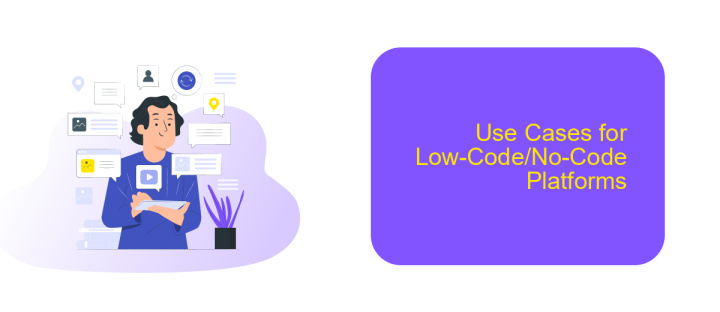Low-code/no-code Examples
In today's rapidly evolving tech landscape, low-code and no-code platforms are revolutionizing the way businesses develop software. These tools empower users to create applications with minimal coding knowledge, significantly reducing development time and cost. This article explores various examples of low-code and no-code solutions, showcasing their potential to streamline workflows and democratize software development across industries.
Introduction
In today's fast-paced digital landscape, the demand for rapid application development has never been higher. Low-code and no-code platforms have emerged as powerful solutions, enabling businesses to develop applications with minimal coding effort. These platforms are transforming the way companies approach software development, making it accessible to a broader range of users.
- Accelerated development timelines
- Reduced dependency on specialized developers
- Enhanced collaboration between technical and non-technical teams
- Cost-effective solutions for small and medium-sized enterprises
One notable example of a service that facilitates seamless integration within low-code/no-code environments is ApiX-Drive. This platform offers a user-friendly interface for connecting various applications and automating workflows without the need for extensive coding knowledge. By leveraging such tools, businesses can streamline their operations and focus more on innovation and growth.
Benefits of Low-Code/No-Code Platforms

Low-code and no-code platforms offer a range of benefits that significantly enhance productivity and efficiency in software development. One of the primary advantages is the accelerated development process. By utilizing visual interfaces and pre-built components, these platforms enable users to create applications much faster than traditional coding methods. This speed not only reduces time-to-market but also allows for rapid prototyping and iteration, which is crucial in today’s fast-paced business environment.
Another key benefit is the democratization of software development. Low-code/no-code platforms empower non-technical users to build and customize applications without needing extensive programming skills. This inclusivity fosters innovation across various departments, as more team members can contribute to the development process. Moreover, these platforms often come with built-in tools for seamless integration with other services. For instance, ApiX-Drive facilitates easy integration with numerous applications, allowing businesses to automate workflows and enhance operational efficiency without writing a single line of code.
Examples of Low-Code/No-Code Platforms

Low-code and no-code platforms have revolutionized the way businesses develop and deploy applications, enabling users with minimal coding knowledge to create sophisticated solutions. These platforms offer a wide range of functionalities, from app development to process automation, making them accessible to a broader audience.
- Appian: A leading low-code platform that allows users to design, build, and optimize complex applications quickly.
- OutSystems: Known for its robust capabilities in enterprise-grade applications, OutSystems supports rapid development and deployment.
- Bubble: A no-code platform that empowers users to build web applications with a visual editor and pre-built templates.
- ApiX-Drive: Specializes in automating workflows by integrating various services and applications without the need for coding skills.
- Zapier: Connects different apps and automates workflows, making it easy to set up integrations and automate repetitive tasks.
These platforms have democratized software development, allowing non-developers to contribute to digital transformation initiatives. Whether you're looking to build a custom application or automate business processes, low-code and no-code platforms like ApiX-Drive provide the tools needed to streamline operations and enhance productivity.
Use Cases for Low-Code/No-Code Platforms

Low-code and no-code platforms are revolutionizing the way businesses operate by enabling non-technical users to develop applications and automate processes. These platforms are particularly useful for small and medium-sized enterprises (SMEs) that lack extensive IT resources but still need to innovate and streamline their operations.
One of the primary use cases for low-code/no-code platforms is the rapid development of internal tools and applications. This allows businesses to quickly address specific needs without relying on a dedicated development team. Additionally, these platforms are excellent for creating customer-facing applications, enhancing user experience without the need for extensive coding knowledge.
- Automating repetitive tasks and workflows
- Creating custom dashboards and reporting tools
- Developing mobile applications for internal and external use
- Integrating various software and services with tools like ApiX-Drive
- Building e-commerce platforms and websites
By leveraging low-code/no-code platforms, businesses can significantly reduce development time and costs. These platforms empower employees across various departments to contribute to digital transformation efforts, ensuring that technology solutions are closely aligned with business needs.
Conclusion
In conclusion, the rise of low-code and no-code platforms has significantly democratized software development, enabling individuals and businesses to create functional applications without extensive coding knowledge. These platforms offer a range of tools and templates that simplify the development process, making it accessible to a broader audience. This shift not only accelerates the time-to-market for new applications but also reduces the costs associated with traditional software development.
Furthermore, the integration capabilities of these platforms, such as those provided by ApiX-Drive, enhance their utility by allowing seamless connections between various services and applications. This enables users to automate workflows and synchronize data across different systems effortlessly. As a result, businesses can achieve greater efficiency and productivity, focusing more on innovation and less on technical complexities. The future of application development looks promising with these advancements, fostering an environment where creativity and functionality thrive together.
FAQ
What is low-code/no-code development?
Who can benefit from low-code/no-code platforms?
Can low-code/no-code platforms be used for automation and integrations?
Are low-code/no-code platforms scalable?
What are some common use cases for low-code/no-code platforms?
Routine tasks take a lot of time from employees? Do they burn out, do not have enough working day for the main duties and important things? Do you understand that the only way out of this situation in modern realities is automation? Try Apix-Drive for free and make sure that the online connector in 5 minutes of setting up integration will remove a significant part of the routine from your life and free up time for you and your employees.

